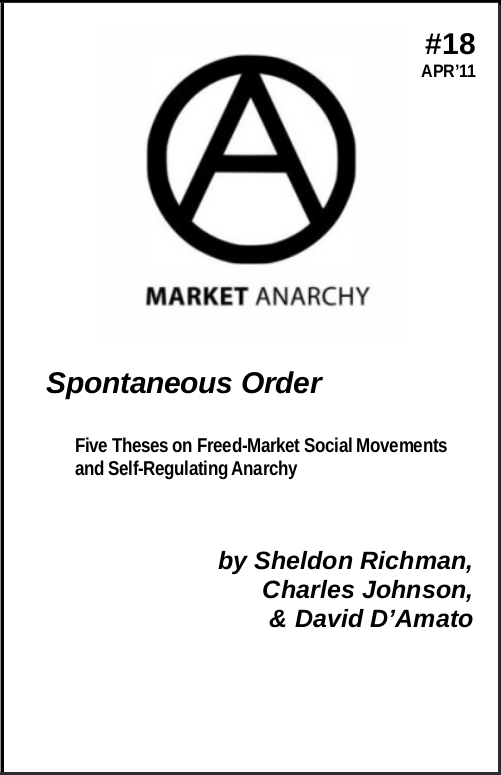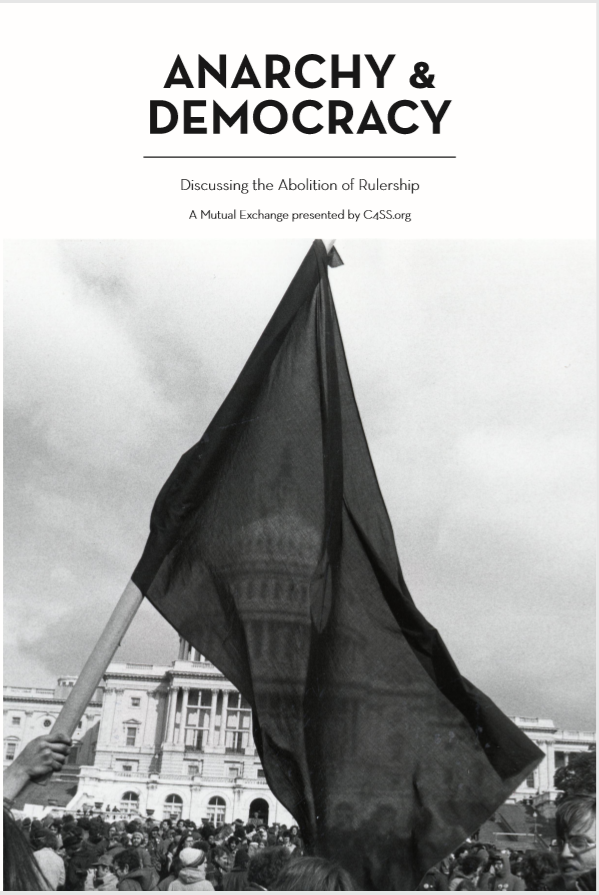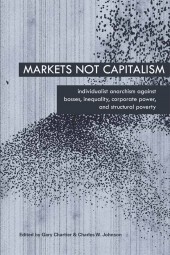We libertarians defend economic freedom, not big business. We advocate free markets, not the corporate economy. And what would freed markets look like? Nothing like the controlled markets we have today. But how often do we hear mass unemployment, financial crisis, ecological catastrophe, and the economic status quo attributed to the voraciousness of “unfettered free markets”? As if they were all around us!
The crises laid at the feet of laissez faire are the crises of markets that are nothing if not fettered. When critics confront us with corporate malfeasance, structural poverty, or socioeconomic marginalization, we should be clear that market principles do not require defending big business at all costs, and that much of what our critics condemn results from government regulation and legal privileges. As a model for analyzing the political edge of corporate power and defending markets from the bottom up, we twenty-first-century libertarians might look to our nineteenth-century roots—to the insights of the American individualists, especially their most talented exponent, Benjamin Ricketson Tucker (1854–1939), editor of the free-market anarchist journal Liberty.
Conventional textbook treatments portray the American Gilded Age as one of relentless exploitation and economic laissez faire. But Tucker argued that the stereotypical features of capitalism in his day were products not of the market form, but of markets deformed by political privileges. Tucker did not use this terminology, but for the sake of analysis we might delineate four patterns of deformation that especially concerned him: captive markets, ratchet effects, concentration of ownership, and insulation of incumbents.
Types of Distortion
Captive Markets. Legal mandates and government monopolies produce captive markets in which customers are artificially locked in to particular services or sellers that they wouldn’t otherwise patronize because political requirements enforce the demand. For example, the car insurance market is shaped by laws requiring insurance and regulating the minimum service that must be purchased. Captive markets legally guarantee privileged companies access to a steady stock of customers, corralled by the threat of fines and arrest.
Ratchet Effects. Legal burdens, price distortions, and captive markets combine to ratchet up fixed costs of living far higher than would prevail in freed markets. To get by, people are constrained by the necessity of covering these persistent, inflexible costs—by selling labor, buying insurance, taking on debt—under artificially rigid circumstances. Ratchets keep many chasing the next paycheck, creating permanent states of financial crisis for the poor.
Concentration. Confiscation, regressive redistribution, and legal monopolies deprive workers of resources while concentrating wealth and economic control within a politically favored business class. Struggling to cover ratcheted fixed costs, workers are dispossessed of the means to make an independent living and enter markets where ownership of land, capital, and key resources are legally concentrated in the hands of a few. Workers therefore depend on relationships with bosses and corporations far more than in freed markets, deforming economic activity into hierarchical relationships and confining rental economies.
Insulation. Captive markets and bailouts protect big players, while legal monopolies, regulatory barriers, and anticompetitive subsidies inhibit substitutes and competition from below. Government support props up big businesses, stifling the market and social pressures that might otherwise be brought to bear. Insulated businesses can treat employees and consumers with far less consideration or restraint; meanwhile, intervention shuts out alternative solutions by blocking smaller, grassroots, or informal competitors.
Tucker’s Big Four
We can, then, turn to Tucker’s central idea: In “State Socialism and Anarchism” (1888), Tucker argued that “Four Monopolies” fundamentally shaped the Gilded Age economy—four central areas of economic activity where government ratchets, concentration, and insulation came together to deform markets into “class monopolies,” regressively reshaping all markets as the effects rippled outward.
The Land Monopoly. Land titles in nineteenth-century America had nothing to do with free markets. All unoccupied land was claimed by government, whose military seized land from Indians, Mexicans, and independent “squatters.” Government ownership and preferential grants monopolized access, excluding free homesteading. (The “Homestead Act,” which supposedly opened Western lands to homesteading, really imposed rigid legal limits on homesteaders that only certain medium-sized commercial farmers could effectively meet. Smaller farms and nonfarmers were excluded.) Tucker identified this concentration of land titles in elite hands as a “land monopoly,” creating a class of privileged landlords by depriving workers of market opportunities to gain freeholds and escape rent.
Since 1888 the land monopoly has dramatically expanded. Governments worldwide have nationalized oil, natural gas, and water resources; in the United States mining rights and fossil fuel exploration are largely accessed through government licenses, due to government’s ownership of 50 percent of the American West. The cost of land is ratcheted and ownership concentrated through zoning codes, eminent domain, municipal “development” rackets, and local policies to keep real estate prices permanently rising. Freed land markets would feature more individual and widely dispersed ownership; land would be less expensive and more often held free and clear; vacant land would be more readily open to homesteading; and titles would be based as easily on sweat equity as on leveraged cash exchanges. Many people would no longer need to rent; those who chose to rent would find that competition had dramatically improved the prices and conditions available on the market.
The Money Monopoly. For Tucker the most damaging of the Big Four was the Money Monopoly, “the privilege given by the government to certain individuals . . . holding certain kinds of property, of issuing the circulating medium,” politically manipulating the money supply, prohibiting alternative currencies, and cartelizing banking, money, and credit. Tucker saw that monetary control not only secured monopoly profits for insulated banks, but also concentrated economic ownership throughout the economy, favoring the large, established businesses that large, established banks preferred to deal with.
Tucker identified the Money Monopoly as an economic force in 1888—before the Fed and fiat currency, the FDIC, Fannie, Freddie, the IMF, or trillion-dollar bailouts to banks “too big to fail.” Today regulatory cartels and political mandates have also captured insurance, alongside credit, savings, and investment, as a Money Monopoly stronghold, forcing workers into rigged markets while shutting out noncorporate, grassroots forms of mutual aid.
Ideas and Extortion
The Patent Monopoly. Tucker condemned monopolies protected by patents and copyrights—“protecting inventors and authors against competition for a period long enough to enable them to extort . . . a reward enormously in excess of . . . their services.” Since copying an idea does not deprive the inventor of the idea, or any tangible property she had before, “intellectual property” meant only a legal monopoly against competitors who could imitate or duplicate the monopolists’ products at lower cost.
“Intellectual property” (IP) has grown vigorously since 1888, as media, technology, and scientific innovation made control over the information economy a linchpin of corporate power. Monopoly profits on IP are the effective business model of Fortune 500 companies like GE, Monsanto, Microsoft, and Disney, which demand virtually unlimited legal power to insulate themselves from competition. Copyright terms quadrupled in length, while massive, synchronized expansions of intellectual protectionism became standard features of neoliberal “free trade” “agreements” like NAFTA and KORUS FTA (United States-Korea Free Trade Agreement). In a freed market such business models would fall—and with them, the ratcheted costs consumers pay for access to culture, medicine, and technology.
The Protectionist Monopoly. Tucker identified the protectionist tariff as a monopoly in the sense that it insulated politically favored domestic producers from foreign competition, and thus ratcheted up daily costs for consumers.
With the rise of multinational corporations and neoliberal trade agreements, tariffs have declined over the years. But the specific legal mechanism was less important to Tucker than the purpose of controlling trade to insulate domestic incumbents. In 1888 that meant the tariff. In 2011, it means a vast network of political controls used to manage the “balance of trade”: export subsidies, manipulation of exchange rates, and multigovernment agencies like the World Bank and IMF.
Metastatic Monopolization
Tucker’s Big Four have only grown more pervasive since the 1880s. But the past century has also seen the metastatic proliferation of government regulatory bodies intended to restructure new transactions and capture new markets. Among today’s Many Monopolies, five are especially pervasive:
The Agribusiness Monopoly encompasses the New Deal system of U.S. Department of Agriculture cartels, surplus buy-ups, subsidized irrigation, export subsidies, and similar measures ratcheting up prices, distorting production toward subsidized crops, and concentrating agricultural activity in large-scale, capital-intensive monoculture. These, inevitably enacted in the name of “small farmers,” invariably benefit large factory farms and agribusiness conglomerates like ADM and Tyson.
The Infrastructure Monopoly includes physical and communications infrastructure. Governments build roads, railways, and airports through eminent domain and tax subsidies, and impose cartelizing regulations on most mass transit. Restricted entry secures monopoly profits for insulated carriers; confiscating money and property to subsidize long-distance transportation and shipping creates tax-supported business opportunities for agribusiness, big-box chain retailers, and other businesses dependent on long-haul trucking. Incumbent telecommunications and media companies like AT&T, Comcast, and Verizon accumulate empires by cartelizing bandwidth; control of broadcast frequencies is concentrated through the FCC’s political allocation; and ownership of telephone, cable, and fiber-optic bandwidth is concentrated through local monopoly concessions for each medium.
The Utility Monopoly grants control over electricity, water, and natural gas to massive, centralized producers through comprehensive planning, subsidies, and regional monopolies. Household generation, polycentric neighborhood systems, or off-the-grid alternatives are crowded out or regulated to death.
Regulatory Protectionism
Regulatory Protectionism may be the most widely dispersed of the Many Monopolies. Like Tucker’s Protectionist Monopoly, it concentrates and insulates incumbent providers by creating hurdles for would-be competitors. Established businesses stifle competition from below by lobbying for regulatory red tape, extortionist fees, and complex licensing for everything from taxi-driving to hairdressing. Industry standards, which would otherwise be set by social convention and market experimentation, are removed from competition and determined by political pull. High compliance costs insulate incumbents who can afford them from competitors who cannot, shutting the poor out of entrepreneurial opportunities and independent livelihoods.
The Health Care Monopoly is a ripple effect of other monopolies but merits special notice because of the all-consuming growth of the medical sector and because health care and insurance so profoundly shape decisions about jobs, money, and financial planning. The central economic fact of health care is a crippling ratchet effect. Patent monopolies ratchet up drug costs and insulate profits for Pfizer and GlaxoSmithKline. The FDA and medical licensing provide a form of regulatory protectionism, constraining the supply of doctors, hospitals, and pharmaceuticals, concentrating profits and further ratcheting costs. A medical need can become a catastrophic cost, effectively requiring comprehensive insurance. Workers once got insurance through fraternal mutual-aid societies, but money monopolies have now thoroughly corporatized the insurance market through subsidies, mandates, and regulatory control. Workers now are tethered to their employers by the cost of insurance “benefits,” while facing the persistent danger of lost coverage, denied claims, and crippling debt.
Tucker’s analysis of the Four Monopolies controlling the Gilded Age economy, supplemented with the new Big Five that our own era has introduced, goes a long way toward showing why existing markets work the way they work and fail for the people they fail for. It may also inspire some objections from today’s libertarians.
The Many Monopolies deform markets toward stereotypically “capitalistic” business, but government intervenes in more than one direction. What about regulations or welfare programs to benefit poor people, or constraints on large, consolidated firms? These exist, but do not necessarily achieve their supposed aims. As shown in Gabriel Kolko’s Triumph of Conservatism, the Progressive regulatory structure and antitrust law, far from curbing big business, form the core of regulatory protectionism, cartelizing and insulating big business. There are also issues of priority and scale. While I object to SBA loans or TANF (Temporary Assistance to Needy Families) as much as any free-marketeer, in this age of trillion-dollar bank bailouts, even when government puts fingers on both sides of the scale, one finger is pushing harder than the other.
What about the explanations market economists offer for corporate firms’ greater efficiency, based on division of labor, economies of scale, or gains from trade? Wouldn’t large corporations outcompete smaller rivals, even without subsidies and monopolies?
But Tucker didn’t reject the division of labor, gains from trade, or large-scale production. Rather he suggested labor, trade, and scale organized along different lines. Independent contracting, co-ops, and worker-managed shops are forms of specialization and trade no less than centralized firms. Scale can be internalized through central management, or externalized through polycentric trade. A corporate economy is only one among many possibilities for dividing labor and exchanging values. The question is whether it predominates because of economic forces that would persist in markets free of structural privilege, or because of predicaments that would dissipate when competitors are free to offer alternatives with less centralization, less management, and more trade and entrepreneurial independence for ordinary workers.
If Tucker’s analysis proves anything, it proves there are many places in economic life where ordinary people are given a hard shove toward spending money they’d rather not spend with trading partners they wouldn’t otherwise keep. The most pervasive, far-reaching government interventions foster economic concentration, commercialization, hyperthyroidal scale, and the consolidated hierarchy needed to manage it—not because they grow naturally in market economies but because they grow out of control in the hothouse of socialized costs and inhibited competition.
The Belt and the Bones
For most of the twentieth century American libertarians were seen as defenders of “capitalism” (though see Clarence Carson’s doubts about that word in the 1985 Freeman article “Capitalism: Yes and No”). Most libertarians, and nearly all their opponents, seemed to agree that libertarianism meant defending business against the attacks of “big government,” and the purpose of laissez faire was to unleash existing forms of commerce from political restraints.
This was almost a complete reversal from the attitude of traditional libertarians like Tucker, which we might call “free-market anti-capitalism.” He was one of the best-known defenders of free markets in nineteenth-century America, happily summarizing his economic principles as “Absolute Free Trade . . . laissez-faire the universal rule.” For Tucker, then, libertarianism meant an attack on economic privilege by removing the political privileges that propped it up, dismantling monopolies by exposing them to competition from below.
The Many Monopolies are pervasive and fundamentally shape the everyday reality of the corporatist economy. So why then have not only the opponents but also the advocates of free markets so often missed Tucker’s analysis, with Progressives constantly laying the blame for inequality, exploitation, and corporate power on “unregulated markets,” while “pro-capitalist” libertarians respond by making excuses for the economic status quo? Paradoxically, it may be that Tucker’s approach is forgotten partly because of the very depth and pervasiveness of the problems it identifies.
The interventions twentieth-century libertarians were most likely to identify and oppose—progressive taxes, welfare, environmental regulations—are surface interventions, economically speaking. While aiming to reform or restrain the corporate state-capitalist economy, they take its basic features—concentration, insulation, ratcheted costs, and corporate power—for granted, attempting only to contain their most unsightly downstream effects. Countervailing “Progressive” regulations are like a belt put on capitalism. A man may need a belt or he may look better without, but his body remains the same with or without the restraint.
The political means that consolidate the Many Monopolies do more than interfere in the outcomes of preexisting market structures. State-capitalist privileges shape basic patterns of ownership, access, and cost for essential goods and factors of production. They fundamentally restructure markets, inventing the class structures of ownership, ratcheted costs, and inhibited competition that produce wage labor, rent, and the corporate economy we face. These primary interventions are no belt for state capitalism to wear or take off; they are its very bones. Without them, what’s left is not a different look for the same body—it’s a totally different organism.
Because you wear a belt on the surface, it’s easy to see and easy to imagine how you might look without it. Twentieth-century libertarians rightly condemned how the belt was hitched by government coercion—but rarely noticed that however much the anti-business belt constrains the state capitalist economy’s natural shape, without the belt it is still a political product shaped by intervention to its pro-business bones. The Monopolies that create capitalists, landlords, and financiers and uphold corporate power are so deeply embedded in the existing economy, so entrenched in consensus politics, it is easy to mistake them for business as usual in a market society.
We might say—with apologies to Shulamith Firestone—that the political economy of state capitalism is so deep as to be invisible. Or it may appear to be a superficial set of interventions, a problem that can be solved by a few legal reforms, perhaps the elimination of the occasional bailout or export subsidy, while preserving intact the basic recognizable patterns of the corporate economy. But there is something deeper, and more pervasive, at stake. A fully freed market means liberating essential command posts in the economy from State control, to be reclaimed for market and social entrepreneurship. The market that would emerge would look profoundly different from anything we have now. That so profound a change cannot easily fit into traditional categories of thought—for example “libertarian” or “left-wing,” “laissez-faire” or “socialist,” “entrepreneurial” or “anti-capitalist”—is not because these categories do not apply but because they are not big enough: Radically free markets burst through them. If there were another word more all-embracing than revolutionary, we would use it.









